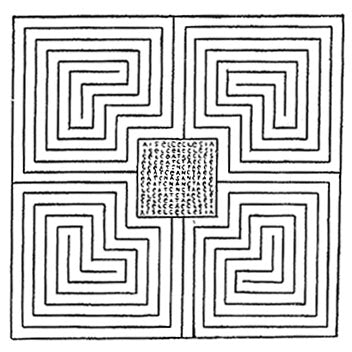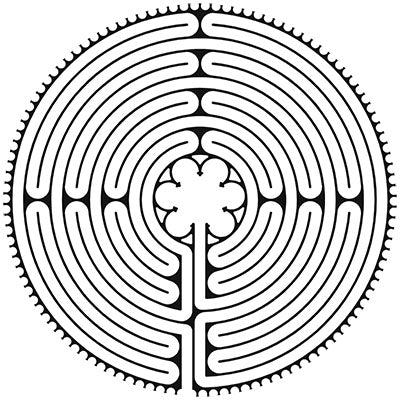Since ancient times the labyrinth has been recognized as a sacred symbol for life or heroic journeys. In Christianity, the labyrinths symbolic meaning is that life's journey is challenging, filled with highs and lows, ups and downs and when one feels lost along their path, God’s salvation is at the at the center of life.
There are more than 5,000 labyrinths currently around the world. You may find them in outdoor spaces like parks, churches, sanctuaries for healing and hospital gardens. Two of the most famous indoor labyrinths were built directly into the cathedral's floor, read on to learn more about Christian labyrinths.
The Bible does not mention a labyrinth specifically within its pages. A labyrinth is a man-made creation to contemplate spiritual concerns and become closer to God.
There are several verses in the Bible that relate to the purpose of a Christian labyrinth. In these verses, God explains to us that He is the way, the path, to salvation, such as:
The first Christian labyrinth was placed on the floor in the St. Basilica of Reparatus in Algeria around 324 AD. The square design features a palindrome of text at its center that reads “Sancta Eclesia” meaning “Holy Church”. If this phrase is read forwards or backwards, vertically or horizontal, it always reads the same way, giving hope that the church is always there to the wanderer of the labyrinth's path.

The French Chartres Cathedral constructed a labyrinth around the year 1230 AD. The Chartres labyrinth is made to walk within a single path which leads in and out featuring 11 circuits counted from the outside to the center. A 6-petal rosette at its center represents the six different kingdoms; mineral, plant, animal, human, angelic, and the divine. The rosette is also known to represent the flowering and healing union of masculine and feminine energies.

Unlike a maze that features dead ends, a labyrinth is “unicursal” with only one path that twists and turns but eventually leads to the center.
In the medieval ages’ monks wandered their monasteries labyrinth paths in quiet contemplation with God. As a walk-through symbol the labyrinth is a creative space that represents the many challenges of life.
The process of walking a labyrinth continues to gain popularity among Christians around the world. Here are some simple steps you can take to walk or pray the labyrinth:
Here are a few reasons why walking a labyrinth can be an essential part of Christian spirituality:
The labyrinth is a physical representation of believers' spiritual journey as they seek a closer relationship with God. Walking the labyrinth can help Christians reflect on their journey of faith and the obstacles they may encounter.
Walking a labyrinth is often done meditative or contemplative, encouraging participants to slow down, breathe deeply, and focus their thoughts on God. This can help to quiet the mind and open the heart to receive God's guidance and direction.
Walking the labyrinth can also be a communal experience, allowing individuals to come together and share their faith experiences. It can be a powerful way to connect with others and support one another on the faith journey.

Walking the Chartres Labyrinth circa 1750 AD
Heavenly Father,
As I enter this labyrinth, I come before You with a humble heart, seeking Your presence and guidance. May the winding path before me be a reflection of my spiritual journey, with each step bringing me closer to You.
As I walk this labyrinth, I pray that You will guide my feet and lead me along the right path. Help me to let go of any burdens or worries that I may be carrying and surrender them to You. Fill me with Your peace and love as I move forward on this journey.
May this labyrinth be a place of spiritual renewal and refreshment for me. May I encounter You in a new and profound way, and may my time here be a reminder of Your constant presence and care.
Thank You, Lord, for the gift of this labyrinth and for the opportunity to draw closer to You through it. May Your blessings be upon me as I walk, and may Your grace sustain me each step of the way.
In Jesus' name I pray,
Amen.
The labyrinth is a symbol for those seeking spiritual growth, healing, or meditating on the path to salvation. While traveling a physical labyrinth may not be possible, a simple alternative is with the use of an ancient tool known as prayer beads.
Looking for a way to devote time for prayer each day? These small prayer beads are great for carrying with you everywhere you go, they easily fit right in your pocket or handbag.

Take a closer look at our labyrinth prayer beads, crafted from beautiful natural stones and feature double-sided labyrinth medallions. From left to right: Bronzite & Tiger Eye, Sodalite & Jasper
 |
 |
Unspoken Elements offers prayer beads, rosaries, and Christian jewelry designed and handmade in the USA since 2011.
